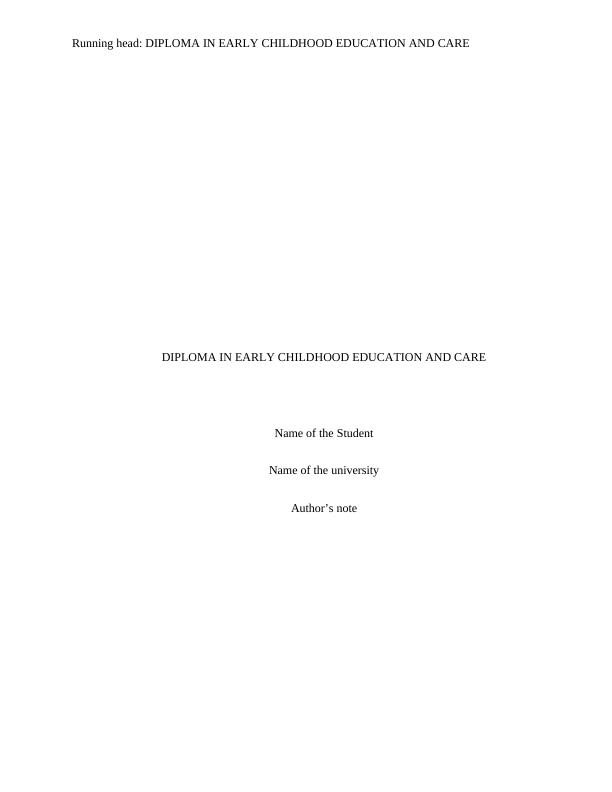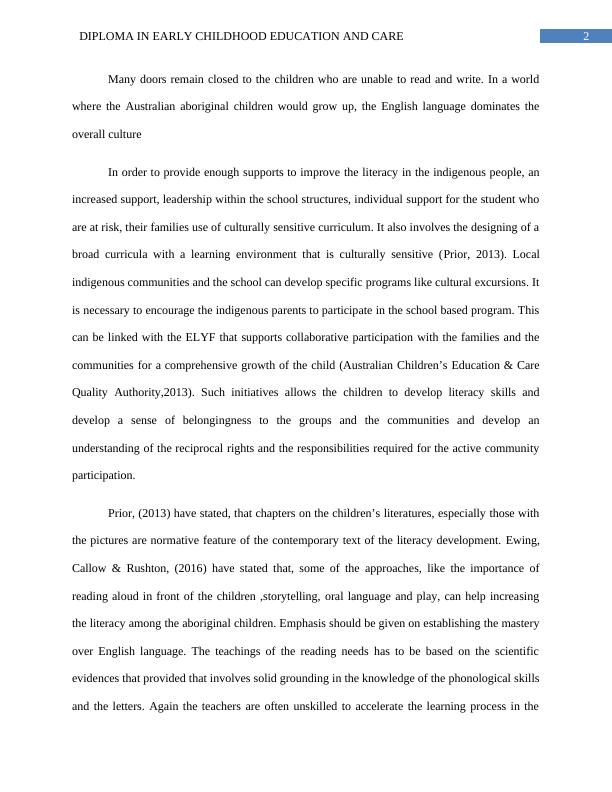Advantages and Disadvantages of Phonics and Whole Language Approaches
Added on 2023-04-07
9 Pages1527 Words344 Views
Running head: DIPLOMA IN EARLY CHILDHOOD EDUCATION AND CARE
DIPLOMA IN EARLY CHILDHOOD EDUCATION AND CARE
Name of the Student
Name of the university
Author’s note
DIPLOMA IN EARLY CHILDHOOD EDUCATION AND CARE
Name of the Student
Name of the university
Author’s note

1DIPLOMA IN EARLY CHILDHOOD EDUCATION AND CARE
Research task 1
Introduction
Despite of considerable efforts, the “closing the gap” in literacy and in school retention in
the aboriginal population is very slow. A survey had shown that an average of 30 % of the
indigenous children across all the areas tested had shown that thy fail the basic tests and did not
reach he National standards for numeracy and literacy. The failure in the basic test seems to rise
to almost 80 % in remote communities of the Northern territory.
This paper will discuss about the various complexities of literacy learning for the
Aboriginal children, and will also give an account of the possible measures for a positive health
literacy outcomes.
Discussions
Some of the reasons that have been identified responsible for the failure to acquire the
basic literacy and the numeracy skills is the fact that most of the indigenous children are likely to
leave school, before they are sufficiently literate to cope up with the demands of the working life.
Again poor school attendance, lack of skilled teaching, lack of culture and education in some of
the indigenous families and the multiples stressors present in the endogenous families, putting
the child’s development at risk can make the incidence of going to school, a low priority in the
life of the people. Some of the other factors are mental health problems.
Research task 1
Introduction
Despite of considerable efforts, the “closing the gap” in literacy and in school retention in
the aboriginal population is very slow. A survey had shown that an average of 30 % of the
indigenous children across all the areas tested had shown that thy fail the basic tests and did not
reach he National standards for numeracy and literacy. The failure in the basic test seems to rise
to almost 80 % in remote communities of the Northern territory.
This paper will discuss about the various complexities of literacy learning for the
Aboriginal children, and will also give an account of the possible measures for a positive health
literacy outcomes.
Discussions
Some of the reasons that have been identified responsible for the failure to acquire the
basic literacy and the numeracy skills is the fact that most of the indigenous children are likely to
leave school, before they are sufficiently literate to cope up with the demands of the working life.
Again poor school attendance, lack of skilled teaching, lack of culture and education in some of
the indigenous families and the multiples stressors present in the endogenous families, putting
the child’s development at risk can make the incidence of going to school, a low priority in the
life of the people. Some of the other factors are mental health problems.

2DIPLOMA IN EARLY CHILDHOOD EDUCATION AND CARE
Many doors remain closed to the children who are unable to read and write. In a world
where the Australian aboriginal children would grow up, the English language dominates the
overall culture
In order to provide enough supports to improve the literacy in the indigenous people, an
increased support, leadership within the school structures, individual support for the student who
are at risk, their families use of culturally sensitive curriculum. It also involves the designing of a
broad curricula with a learning environment that is culturally sensitive (Prior, 2013). Local
indigenous communities and the school can develop specific programs like cultural excursions. It
is necessary to encourage the indigenous parents to participate in the school based program. This
can be linked with the ELYF that supports collaborative participation with the families and the
communities for a comprehensive growth of the child (Australian Children’s Education & Care
Quality Authority,2013). Such initiatives allows the children to develop literacy skills and
develop a sense of belongingness to the groups and the communities and develop an
understanding of the reciprocal rights and the responsibilities required for the active community
participation.
Prior, (2013) have stated, that chapters on the children’s literatures, especially those with
the pictures are normative feature of the contemporary text of the literacy development. Ewing,
Callow & Rushton, (2016) have stated that, some of the approaches, like the importance of
reading aloud in front of the children ,storytelling, oral language and play, can help increasing
the literacy among the aboriginal children. Emphasis should be given on establishing the mastery
over English language. The teachings of the reading needs has to be based on the scientific
evidences that provided that involves solid grounding in the knowledge of the phonological skills
and the letters. Again the teachers are often unskilled to accelerate the learning process in the
Many doors remain closed to the children who are unable to read and write. In a world
where the Australian aboriginal children would grow up, the English language dominates the
overall culture
In order to provide enough supports to improve the literacy in the indigenous people, an
increased support, leadership within the school structures, individual support for the student who
are at risk, their families use of culturally sensitive curriculum. It also involves the designing of a
broad curricula with a learning environment that is culturally sensitive (Prior, 2013). Local
indigenous communities and the school can develop specific programs like cultural excursions. It
is necessary to encourage the indigenous parents to participate in the school based program. This
can be linked with the ELYF that supports collaborative participation with the families and the
communities for a comprehensive growth of the child (Australian Children’s Education & Care
Quality Authority,2013). Such initiatives allows the children to develop literacy skills and
develop a sense of belongingness to the groups and the communities and develop an
understanding of the reciprocal rights and the responsibilities required for the active community
participation.
Prior, (2013) have stated, that chapters on the children’s literatures, especially those with
the pictures are normative feature of the contemporary text of the literacy development. Ewing,
Callow & Rushton, (2016) have stated that, some of the approaches, like the importance of
reading aloud in front of the children ,storytelling, oral language and play, can help increasing
the literacy among the aboriginal children. Emphasis should be given on establishing the mastery
over English language. The teachings of the reading needs has to be based on the scientific
evidences that provided that involves solid grounding in the knowledge of the phonological skills
and the letters. Again the teachers are often unskilled to accelerate the learning process in the

End of preview
Want to access all the pages? Upload your documents or become a member.
Related Documents
Healthy child development Assignment PDFlg...
|9
|2238
|280
Healthy child development - Assignment PDFlg...
|9
|2193
|182
Collaborating with Families and Aboriginal People in Early Childhood Educationlg...
|6
|759
|402
CHCECE001 Develop cultural competencelg...
|6
|716
|171
Challenges and Strategies for Literacy Learning in Aboriginal Childrenlg...
|10
|2164
|373
Communication, language and literacylg...
|11
|2347
|126
